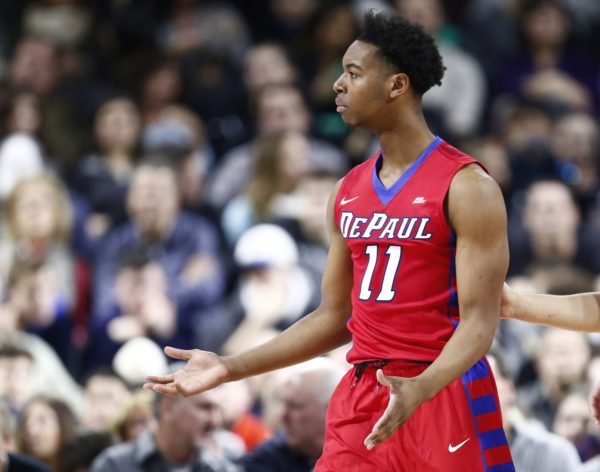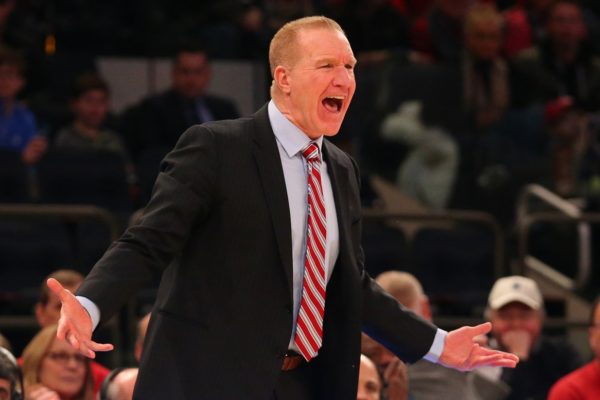Big East Conference Preview: DePaul, Providence, St. John’s, Marquette
Posted by Justin Kundrat on November 7th, 2016The Big East microsite will be rolling out previews on all 10 teams this week, sorted into three tiers. Today we review the projected bottom tier of teams — DePaul, Providence, St. John’s and Marquette.
#10: DePaul
Roster turnover begets roster turnover in Chicago, where the Blue Demons have continually struggled to build upon any success. Now entering his senior year, Billy Garrett Jr.‘s potential never truly materialized so many have turned their attention to sophomore Eli Cain — a long, 6’6 slasher who relentlessly attacks the rim while also connecting on a healthy 42.5 percent of his three-point shots. But while backcourt mates Garrett and Cain should keep DePaul’s offense moving forward, the starting frontcourt has completely dissolved. The first attempt at a solution will be Levi Cook, a 6’10″ transfer who originally committed to West Virginia before a knee injury hampered his recruiting process. The second attempt will be forward Tre’Darius McCallum, a JuCo transfer with two years of eligibility remaining. But until either newcomer demonstrates an ability to compete at a high-major level of basketball, the offense will remain predominantly backcourt-oriented. This might suffice if Cain can improve in finishing around the rim and fourth-year transfer Chris Harrison-Docks supplies a scoring punch off the bench, but winning teams are generally built on two-way players and DePaul hasn’t ranked among the top half nationally in defensive efficiency in six years. Strong defensive units require roster continuity and Dave Leitao clearly needs more time.
#9: Providence
The Friars have now been to three straight NCAA Tournaments under Ed Cooley so it feels strange to rank them ninth in the preseason conference standings. Providence can certainly outperform this projection and prove all of the preseason pundits wrong, but it’s going to take a few things that last season failed to provide. First, junior Rodney Bullock will need to step into an alpha dog role after spending two seasons in the shadows alongside Kris Dunn and Ben Bentil. The 6’8 forward put on some remarkable offensive displays last season but failed to do so consistently. Some of that deficiency was simply a product of low usage, but other times it was because of the lethal combination of foul trouble and poor shooting. Second, some combination of swingmen Jalen Lindsey and Ryan Fazekas will need to fulfill the role of a knockdown shooter in order to properly space out the offense. Last season’s team lacked a true threat from three-point range, and without Dunn or Bentil attracting all of the defensive attention, they will now collapse around Bullock inside and cut off any penetration from Cartwright. Next is the ever-present issue of legitimate size. With only one player above 6’8″ on this roster, rebounding is going to require a collective effort with a cautious eye toward foul trouble. It won’t hurt if junior guard Kyron Cartwright has a breakout season by building on an extremely underrated playmaking skill set.
#8: St. John’s
Consider this ranking a sign of respect for the Red Storm in that they are coming off a 1-17 Big East finish where they lost 21 of their last 22 games. Record aside, there is good talent in place that just needs time to develop. In short, the positives are in the physical, shot-blocking frontcourt of Yankuba Sima and Kassoum Yakwe, who combined to block nearly 15 percent of opponents’ shot attempts (sixth nationally) last year. Pair the duo with the incoming backcourt of Marcus LoVett Jr. and Shamorie Ponds, both four-star recruits, and it feels like a complete roster. Like last season, however, there will still be some significant growing pains and moments of disconnect along the way. The offensive production of Sima and Yakwe was unpolished last season and neither LoVett nor Ponds has yet played a minute at the collegiate level. There are also some returning players in guards Federico Mussini and Malik Ellison, but their roles are currently in flux with the new additions. This will probably look less like a team and more a collection of talented players for the first half of the year, but St. John’s could start to get by the time conference play comes around. In a sense, this program is in a similar place to where Seton Hall was two seasons ago with the arrival of its talented freshman class. Its growing pains will be inevitable, but it’s also impossible to ignore the talent on the roster.
#7: Marquette
The obvious question here is how the Golden Eagles will fare without super-freshman Henry Ellenson, the team’s go-to-scorer and eventual lottery pick last season. Normally, losing ball-dominant players is devastating to an offense, especially in the case where the remaining roster is ill-equipped with scorers. But Steve Wojciechowski has plenty of scorers remaining, and the addition of sharp-shooting transfers Katin Reinhardt (37.3% 3FG) and Andrew Rowsey (38.2% 3FG) might actually make the offense more efficient. It enables Marquette to shift from a clunky post-centric offense to a four-out, one-in system that relies on the well-developed low post passing and screen setting abilities of senior Luke Fischer. Removing a big man from the lineup and replacing him with a shooter will also open up driving lanes for the likes of Haanif Cheatham and Duane Wilson, two guards who are most effective when attacking the rim. The offensive end appears to have a competent lineup in place. But in order for these smaller lineups to be effective, a significant degree of responsibility falls on the big man to serve as a defensive cornerpiece. Can Fischer become an effective rim protector and rebounder while also staying out of foul trouble? There is minimal depth on the Golden Eagles’ roster behind him, so this season’s outcome will hinge on that answer.












































